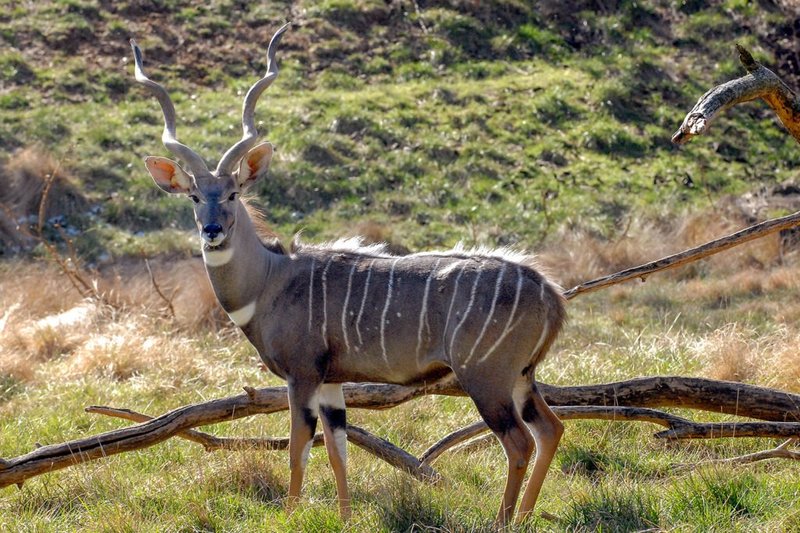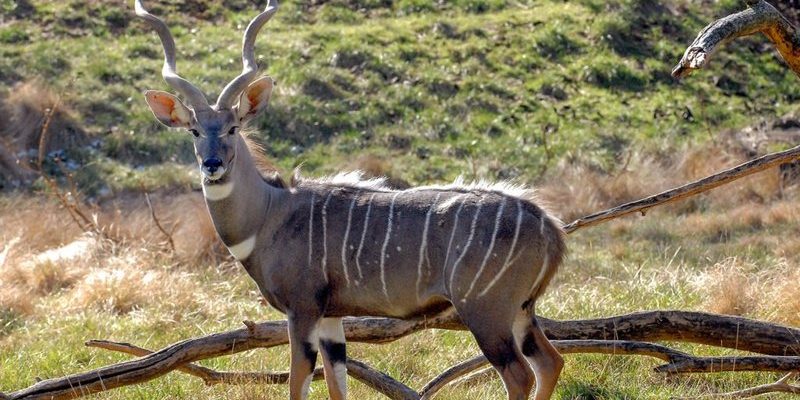
Lesser kudus are slipping away from their natural habitats due to human activities, habitat loss, and poaching. It’s like a slow, quiet whisper that grows louder as we take away their homes and lives. You might be wondering how serious the situation is, and what we can do about it. Let me explain how their status as endangered influences not only their survival but also the health of the ecosystems they inhabit.
What is the Lesser Kudu?
The *lesser kudu* (*Tragelaphus imberbis*) is a medium-sized antelope that can be found primarily in the *savannahs and woodlands* of East Africa. They have a unique appearance, with males sporting impressive twisted horns that can reach lengths of up to 37 inches. Their coats are a rich chestnut brown, adorned with white stripes and spots, which help them camouflage in their natural environment.
These animals are not just beautiful; they play an important role in their ecosystems. As herbivores, they help maintain plant life by grazing on various grasses and shrubs. This grazing contributes to the balance within their habitat, promoting the growth of diverse vegetation. The lesser kudu’s behavior also supports seed dispersal, which is essential for the regeneration of plants.
However, these majestic creatures face significant threats, primarily due to human encroachment on their habitats. As areas become more populated or developed, the space for lesser kudus shrinks, leading to a severe decline in their numbers.
Current Conservation Status
The International Union for Conservation of Nature (IUCN) categorizes the lesser kudu as *Near Threatened*. This means they are not currently classified as endangered, but they are at risk of becoming so. Their populations are decreasing, primarily due to factors such as habitat degradation and hunting.
The lesser kudu’s range has considerably shrunk over the years, primarily due to agricultural expansion and urban development. Areas that once served as safe havens for many wildlife species are now replaced by farmland or cities. This shrinking habitat not only puts pressure on the existing populations but also leads to fragmentation, making it harder for kudus to find mates and maintain healthy gene pools.
Another pressing issue is poaching, which remains a significant problem in many areas. Though lesser kudus are not typically sought after for their meat, they can fall victim to hunters targeting other game. This indiscriminate hunting can lead to further population declines and disrupt the delicate balance of their ecosystems.
Key Threats to Lesser Kudu Population
The challenges faced by the lesser kudu are multifaceted. Here’s a closer look at some of the main threats:
- Habitat Loss: As more land is used for agriculture, forests and savannahs that kudus depend on for shelter and food are disappearing.
- Poaching: Hunting for bushmeat and trophies, while often not aimed specifically at lesser kudus, still leads to unintended consequences.
- Competition from Livestock: As cattle and other livestock graze in the same areas, less food is available for kudus.
- Human-Wildlife Conflict: As kudus venture closer to human settlements in search of food, conflicts arise, often leading to harmful outcomes for the animals.
Understanding these threats is crucial for developing effective conservation strategies. Here’s the thing: the survival of lesser kudus is closely linked to the health of their entire ecosystem. Protecting them means protecting a whole network of life.
Conservation Efforts for the Lesser Kudu
Many organizations and governments are stepping up efforts to protect the lesser kudu. Conservation initiatives aim to safeguard their habitats and promote population recovery. These programs often focus on creating protected areas, enforcing anti-poaching laws, and raising awareness about the species.
Protected areas are essential for the survival of lesser kudus, as they provide safe havens free from human interference. National parks and reserves in East Africa play a critical role by offering a sanctuary where these animals can roam and breed without the looming threat of poachers or habitat loss.
Education and community involvement are also key components of conservation efforts. By engaging local communities in protecting their wildlife, we can create a sense of shared responsibility. Programs that promote sustainable farming practices can help reduce encroachment into kudu habitats, allowing both people and wildlife to thrive.
The Role of Ecotourism in Lesser Kudu Conservation
Ecotourism is a growing field that can significantly impact the conservation of lesser kudus. By attracting visitors interested in wildlife and nature, local communities can find economic benefit in preserving these animals instead of hunting them.
Imagine standing quietly in the African bush, spotting a lesser kudu gracefully moving among the trees. That experience not only creates lasting memories but can also generate funds that support local conservation efforts. With this financial support, communities can invest in protecting their natural resources and wildlife.
However, it’s essential for ecotourism to be managed sustainably. Unregulated tourism can lead to disturbances in wildlife behavior and habitat degradation. That’s why it’s vital to have guidelines and regulations in place, ensuring visitors contribute positively to conservation rather than exacerbating existing problems.
Why Should We Care About the Lesser Kudu?
You might be asking yourself, why does the lesser kudu matter? Well, it’s not just about saving one species. The lesser kudu is a part of a larger puzzle. Each species in an ecosystem contributes to its overall health and stability. When one piece is removed, it can set off a chain reaction that affects many others.
Moreover, these animals symbolize the rich biodiversity that East Africa is known for. Preserving lesser kudus and their habitats is vital not only for their survival but also for maintaining the unique ecosystems that attract millions of tourists each year.
In a broader context, caring for wildlife like the lesser kudu is also about honoring the intricate balance of life on Earth. Each species plays a role, and with their contributions disappearing, we risk losing the connections and beauty that make our planet unique.
How You Can Help
Lastly, if you’re feeling inspired to make a difference, there are several ways you can help:
- Support Conservation Organizations: Donate to or volunteer with organizations working to protect wildlife and their habitats.
- Spread the Word: Raising awareness about the lesser kudu and other endangered species can inspire others to take action.
- Practice Sustainable Living: Adopt eco-friendly habits in your daily life to lessen your impact on the environment.
- Visit Responsibly: If you travel to areas where lesser kudus live, choose eco-friendly tours that support conservation efforts.
Every small action counts. Together, we can work towards a future where lesser kudus thrive alongside us.
In conclusion, while the lesser kudu faces numerous challenges, there is hope through concerted conservation efforts and community engagement. By understanding the threats they face and taking action to address these issues, we can help ensure that future generations will also enjoy the sight of these remarkable animals. Protecting the lesser kudu not only benefits them but also enriches our world as a whole.

